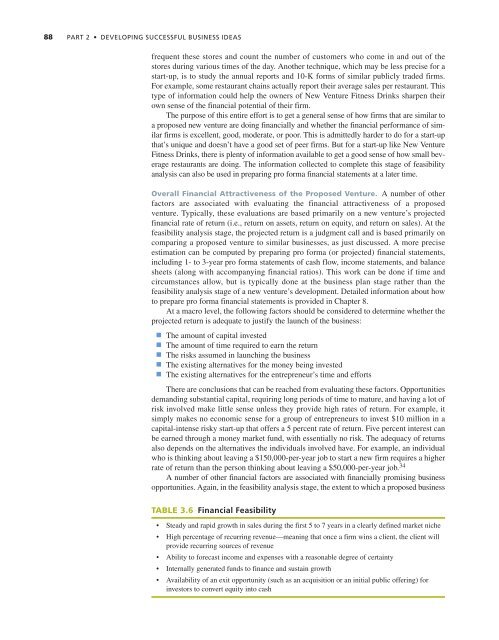feasibility analysis feasibility analysis
feasibility analysis feasibility analysis
feasibility analysis feasibility analysis
You also want an ePaper? Increase the reach of your titles
YUMPU automatically turns print PDFs into web optimized ePapers that Google loves.
88 PART 2 • DEVELOPING SUCCESSFUL BUSINESS IDEAS<br />
frequent these stores and count the number of customers who come in and out of the<br />
stores during various times of the day. Another technique, which may be less precise for a<br />
start-up, is to study the annual reports and 10-K forms of similar publicly traded firms.<br />
For example, some restaurant chains actually report their average sales per restaurant. This<br />
type of information could help the owners of New Venture Fitness Drinks sharpen their<br />
own sense of the financial potential of their firm.<br />
The purpose of this entire effort is to get a general sense of how firms that are similar to<br />
a proposed new venture are doing financially and whether the financial performance of similar<br />
firms is excellent, good, moderate, or poor. This is admittedly harder to do for a start-up<br />
that’s unique and doesn’t have a good set of peer firms. But for a start-up like New Venture<br />
Fitness Drinks, there is plenty of information available to get a good sense of how small beverage<br />
restaurants are doing. The information collected to complete this stage of <strong>feasibility</strong><br />
<strong>analysis</strong> can also be used in preparing pro forma financial statements at a later time.<br />
Overall Financial Attractiveness of the Proposed Venture. A number of other<br />
factors are associated with evaluating the financial attractiveness of a proposed<br />
venture. Typically, these evaluations are based primarily on a new venture’s projected<br />
financial rate of return (i.e., return on assets, return on equity, and return on sales). At the<br />
<strong>feasibility</strong> <strong>analysis</strong> stage, the projected return is a judgment call and is based primarily on<br />
comparing a proposed venture to similar businesses, as just discussed. A more precise<br />
estimation can be computed by preparing pro forma (or projected) financial statements,<br />
including 1- to 3-year pro forma statements of cash flow, income statements, and balance<br />
sheets (along with accompanying financial ratios). This work can be done if time and<br />
circumstances allow, but is typically done at the business plan stage rather than the<br />
<strong>feasibility</strong> <strong>analysis</strong> stage of a new venture’s development. Detailed information about how<br />
to prepare pro forma financial statements is provided in Chapter 8.<br />
At a macro level, the following factors should be considered to determine whether the<br />
projected return is adequate to justify the launch of the business:<br />
■ The amount of capital invested<br />
■ The amount of time required to earn the return<br />
■ The risks assumed in launching the business<br />
■ The existing alternatives for the money being invested<br />
■ The existing alternatives for the entrepreneur’s time and efforts<br />
There are conclusions that can be reached from evaluating these factors. Opportunities<br />
demanding substantial capital, requiring long periods of time to mature, and having a lot of<br />
risk involved make little sense unless they provide high rates of return. For example, it<br />
simply makes no economic sense for a group of entrepreneurs to invest $10 million in a<br />
capital-intense risky start-up that offers a 5 percent rate of return. Five percent interest can<br />
be earned through a money market fund, with essentially no risk. The adequacy of returns<br />
also depends on the alternatives the individuals involved have. For example, an individual<br />
who is thinking about leaving a $150,000-per-year job to start a new firm requires a higher<br />
rate of return than the person thinking about leaving a $50,000-per-year job. 34<br />
A number of other financial factors are associated with financially promising business<br />
opportunities. Again, in the <strong>feasibility</strong> <strong>analysis</strong> stage, the extent to which a proposed business<br />
TABLE 3.6 Financial Feasibility<br />
• Steady and rapid growth in sales during the first 5 to 7 years in a clearly defined market niche<br />
• High percentage of recurring revenue—meaning that once a firm wins a client, the client will<br />
provide recurring sources of revenue<br />
• Ability to forecast income and expenses with a reasonable degree of certainty<br />
• Internally generated funds to finance and sustain growth<br />
• Availability of an exit opportunity (such as an acquisition or an initial public offering) for<br />
investors to convert equity into cash

















